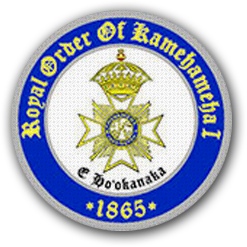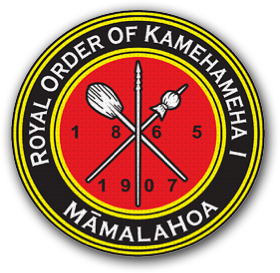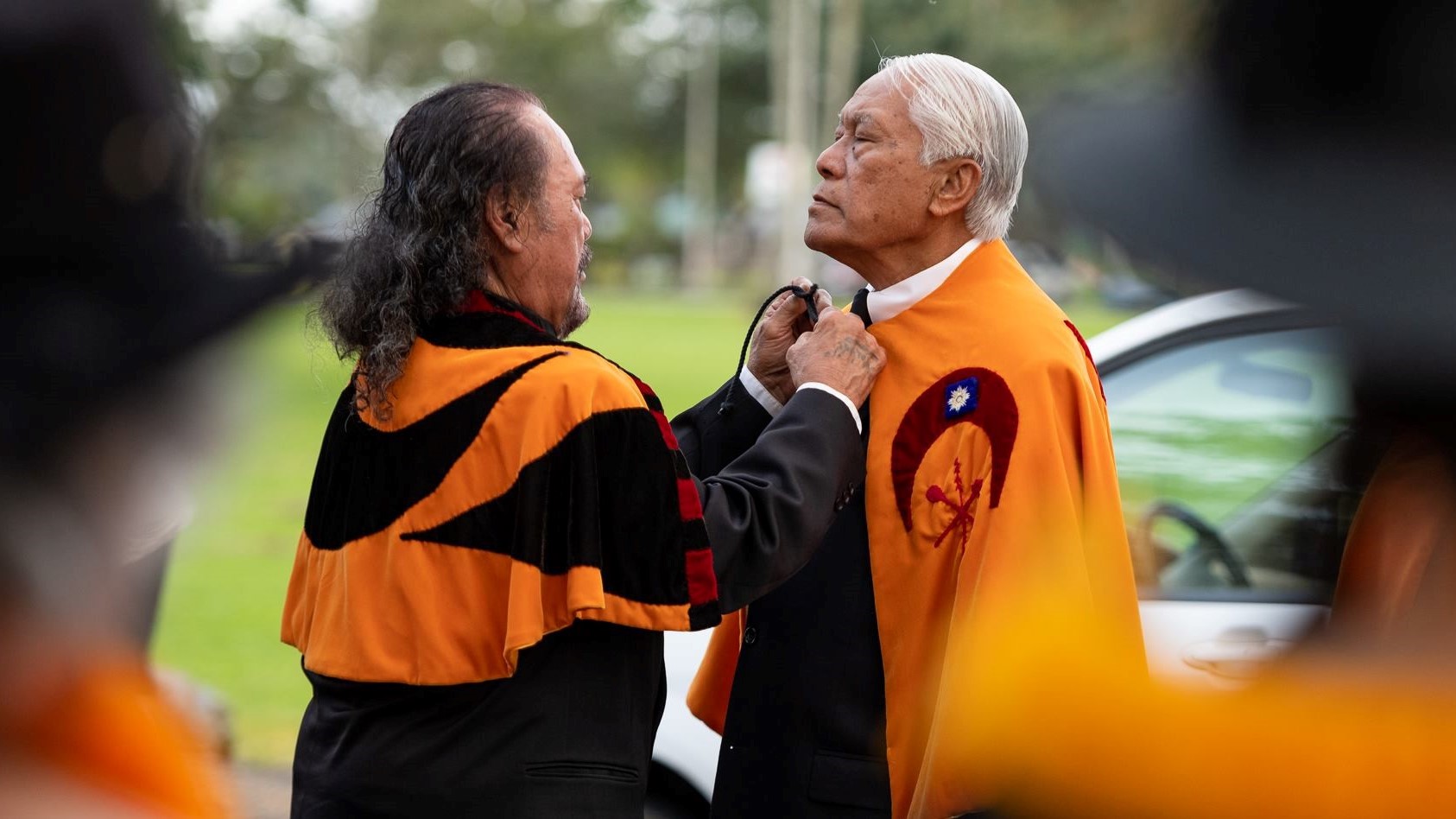KAMEHAMEHA FESTIVAL
The Kamehameha Festival (Festival) is part of the Kamehameha Day celebration that was first established in 1871 as a national holiday of the Kingdom of Hawai‘i. Kamehameha Day honors the memory of Kamehameha who united the Hawaiian Islands in 1810 to became Hawai‘i’s first King. The Royal Order of Kamehameha I, Māmalahoa, has been involved in the presentation of the Kamehameha Day Celebration in Hilo, Hawai‘i since 1908. In more modern times Māmalahoa has presented the Kamehameha Day celebration on Moku Ola (Island of Life) in Hilo Bay since 1985. In 2008 Māmalahoa revitalized Hilo’s Kamehameha Day celebration with an expanded and more culturally significant event called the Kamehameha Festival (Festival).
Today the Festival continues to honor Kamehameha and acts to protect, preserve, and perpetuate the Hawaiian culture by sharing traditional Hawaiian dance, music, chant, practices, arts, and crafts with thousands of island residents and visitors from around the world. The Kamehameha Festival is held every year on Kamehameha Day (June 11) in Hilo, Hawai‘i on Moku Ola (Island of Life). The Festival begins at 10:00 am and ends at 4:00 pm, is free and open to the public, and remains an alcohol, smoke, and drug free event. Website at KamehamehaFestival.org.
MĀLAMA MAUNA KEA
For scientist and astronomers the summit of Mauna Kea is recognized as the world’s premier location to observe the universe. However, for Hawaiians, the summit is recognized and respected as an extremely sacred place. For Hawaiians, it is here that Wakea, the sky father, and Papa, the earth mother, gave birth to the Hawaiian Islands. Early Polynesians considered their highest points of land as the most sacred; and Mauna Kea being the highest mountain in Polynesia, was considered the most sacred place of all. The difference between these two perspectives is the basis of much controversy and contention regarding the use and development of Mauna Kea.
Due to the sacred nature of Mauna Keaʻs summit and the continuing threat of additional astronomy development and military build-up, the Royal Order of Kamehameha I, Māmalahoa maintains a standing committee to monitor Mauna Kea. The committee collaborates with environmentalist, Hawaiian activist, individuals, and other groups dedicated to the protection, preservation, and perpetuation of the natural and cultural resources of Mauna Kea.
“We, by our protocols, must protect the iwi (bones) of our ancestors and all that is sacred to our kingdom. The Royal Order of Kamehameha is prepared to protect and defend the integrity and honor of Mauna Kea and the Native Hawaiian people . We will continue to be involved in working with the people of Hawai`i towards lasting protection and oversight of Mauna Kea that the people can be proud of.”
Paul Neves
Ali‘i ‘Ai Moku
Royal Order of Kamehameha I
Māmalahoa
12/21/01
Note:
For a visual history of some of Māmalahoa’s activities on Mauna Kea, please visit the web site of our friend Tom Whitney.
For information on the current status of projects and plans that impact Mauna Kea, please visit KAHEA.
A comprehensive report regarding Mauna Kea and its cultural, religious, and environmental significance, was prepared by Māmalahoa and Mauna Kea Anaina Hou and is available here.
10/20/2018 – Māmalahoa’s resolution to establish a POSITION STATEMENT OF THE ROYAL ORDER OF KAMEHAMEHA REGARDING MAUNA KEA was adopted by the 2018 Papa Ali i (Grand Council of Chiefs) on 10/20/2018 held in Kona, Moku o Keawe.
HA‘A KOA – DANCE OF THE WARRIOR
“Some” of the Benefits and Applications:
Ha‘a Koa Term Defined
Ha‘a = low bent knee dance while Koa = Warrior, as such, the term Ha‘a Koa literally means the low bent knee dance of the warrior. Accordingly, Ha‘a Koa does not refer to any specific dance, but to style of dance that is low to the ground, and ho‘o koa (warrior like) in ‘ike (look, feel, sound, spirit and nature). Ha‘a Koa is an important traditional cultural protocol that celebrates Hawaii’s proud warrior heritage and the virtues of strength and honor. A protocol that can be used to unify and empower kānaka to take on a difficult task; honor an esteemed individual, place, or event; or advocate for a pono cause. A protocol that can benefit the Lāhui in many different ways and at many different levels, physically, mentally, and spiritually.
I. Ha‘a Koa as a means to Unify and Empower:
Ha‘a Koa is an important traditional cultural protocol that celebrates Hawaii’s proud warrior heritage and the virtues of strength and honor. A protocol that can be used to unify and empower kānaka to take on a difficult task; honor an esteemed individual, place, or event; or advocate for a pono cause. A protocol that can benefit the Lāhui in many different ways and at many different levels, physically, mentally, and spiritually.
II. Ha‘a Koa as a Tool for Change:
The Ha‘a Koa may be used as a means of expressing frustration at the laws, policies, or direction of governments, and be used as a cultural rallying cry. Hawaiian activism at the community, state and national level is ongoing. There is rarely a day without Hawaiian rights being challenged and Hawaiian views being voiced. The Ha‘a Koa can be used to focus attention on issues affecting Hawaiians today and show the depth, unity, and commitment of kānaka to promote change.
III. Ha‘a Koa as a Manifestation of Mana:
Mana is the driving force of Kanaka Maoli. The Ha‘a Koa is one method to pull the Mana from the honua (earth) and our kāpuna. It fills the body and flows out to all around. It inspires, empowers, and promotes forward motion in both participants and spectators.
IV. Ha‘a Koa as a Tool to Reconnect:
The Ha‘a Koa is not merely an adrenaline boost or simple display of emotions, it is both a remembrance of who we were and an awakening of who we are. It takes us back, if only for a moment, and reconnects us to the spirit of our warrior ancestors.
V. Ha‘a Koa as a new Hawaiian Icon:
The Ha‘a Koa celebrates a dimension of the Hawaiian culture that has been absent for too long. Yes we have the Hula, Aloha Shirt, Flower Leis, Pineapples, and the Aloha Spirit, but we were also a warrior society. The Ha‘a Koa can be that symbol and icon of our once proud warrior heritage that was and remains a significant part of our history and culture.
VI. Ha‘a Koa as a Greeting and Sign of Respect and Honor:
The Ha‘a Koa is a representation of a significant part of our culture, our once proud warrior society. To share this aspect of our culture with an individual or hui is a sign of great respect and honor. An appropriate application here may include the sharing of a Ha‘a Koa as a welcome and greeting protocol with visitors, honored guest, or someone returning home from a far place.
VII. Ha‘akoa as a Pre-Competition Protocol:
Ha‘akoa can unify and empower a team for the competition at hand. A Ha‘akoa that celebrates who a team is and speaks of their strength and skills, does not in and of itself disrespect the opposition nor is it designed to do so. However, when delivered with unity, power, and mana, Ha‘akoa may very well dishearten and intimidate the opposition.
VIII. Innovations and Traditions:
The Hawaiian culture like all cultures continues to evolve including its practices and protocols such as Ha‘akoa. As kānaka we all have the inherent kuleana to ensure that Ha‘akoa remain a traditional culturally competent protocol, that is, being uniquely Hawaiian in word, motion, and ‘ike (look, feel, spirit, and nature) for current and future generations.
HISTORY & NEED:
Ka Mate is recognized as the foremost Haka in Aotearoa. The Haka is recognized by the Maori as a traditional pre-battle protocol. The tremendous popularity and growth of Ka Mate, with roots to the early 19th century, is not only a Polynesian phenomenon but recognized and practiced in different countries around the world. Hawaii’s embrace of the Haka reflects this phenomenon and the continued renaissance in things Hawaiian, and in the alternative, things Polynesian. A prime example here is the University of Hawai‘i football team that incorporated Ka Mate into its pre-game program beginning in 2006. However, due to strong internal and external influences, this Haka began to be Hawaiianized in an attempt to have something more Hawaiian called a Hawaiian Haka or Ha‘a.
However, the need for a strong masculine protocol became evident much earlier with the early voyages of the Hōkūleʻa beginning in 1976. On arriving at different South Pacific islands, Hōkūleʻa crew members were greeted with haka and haka type protocols. However, crew members had no appropriate strong masculine response and at times responded with a hula. A common question from our Polynesian cousins at this time were, “where are your warriors?”, “where are your haka?” In time Hōkūleʻa crews started to create their own Hawaiian Haka or Ha‘a to share at the appropriate times.
During this same period (mid 1970s), the practice of lua (Hawaiian martial arts) was making a public emergence with the hui Paku‘i a Lua. The practitioners at this time wanted to incorporate a strong masculine protocol as part of their practices, however, there were no traditional masculine protocols known at that time. As such, the hui created their own Hawaiian Haka or Ha‘a that also included Marquesas words and movements.
Early works to create a masculine Hawaiian protocol that would reflect the energy and intent of the Maori Haka have received mixed reviews from the community and especially cultural purist who believe such a protocol must be culturally competent, that is, uniquely Hawaiian in language, movement and ‘ike. As such the Hawaiian Haka or Ha‘a in this context, remained a controversial subject.
In 2008, in an attempt to provide education and clarity on this issue, the Royal Order of Kamehameha conducted the first ever public discussion on this subject, The Ha‘a Koa Conference with the theme “Discovering the Hawaiian Haka”. The Conference took place at the University of Hawai‘i in Hilo and drew over 150 participants. The Conference featured a recognized and respected panel of Hula, Lua, Cultural, and Language experts. At the conclusion of the conference, there was consensus on the following three important issues:
(1) As a warrior society, it can only be assumed that Hawaiians, like other Polynesians did practice pre-battle protocols to unify and empower themselves before conflict. However, exactly what those protocols may have been are no longer known today, such ancient protocols have been lost to history. As such all haka like protocols practiced in Hawai‘i today are recognized as modern day creations with varying degrees of cultural competency.
(2) Strong masculine cultural protocols are needed and would benefit the Lāhui today. As such, there is a need to restore these traditional protocols once practiced by our kūpuna. However, such protocols must be restored in a culturally competent manor, that is, they must be uniquely Hawaiian in language, movement, and ‘ike.
(3) There are no recognized traditional names for the masculine cultural protocols that are being discussed. The most common words/terms currently used are Ha‘a or Ai Ha‘a referring to a low bent knee dance. However, this word/term does not capture the warrior nature and intent of the masculine cultural protocol that we are discussing. There is a need for a culturally competent name/term to describe this masculine protocol. Accordingly, it was felt that Ha‘akoa, where ha‘a means bent knee dance, and koa means warrior, would be an appropriate name/term for this protocol moving forward, i.e., Ha‘akoa, the bent kneed dance of the warrior, or simply, dance of the warrior.
2018 – Ha‘akoa Eia Hawai‘i
Eia Hawai‘i is a chant whose origins lie in the 12th century voyage of the chief Mō‘īkeha from Kahiki to Hawai‘i. When Mō‘īkeha’s canoe first approaches land, his foster son and navigator, Kamahualele, urges his ali‘i to settle here by chanting “Eia Hawai‘i, a he moku, a he kanaka – Here is Hawai‘i, an island, a man.” According to Abraham Fornander, this mele was delivered from the pola or crossboards of the royal double-hulled canoe just offshore of Hilo (Hilo Bay).
In 2018, Ali‘i ‘Aimoku Sir David M. Heaukulani K.G.C.K., commissioned the creation of a Ha‘akoa utilizing the words of Eia Hawai‘i. , Lani Ali‘i Pua Ishibashi, Ali‘i Sky Ishibashi, Ali‘i Wally Wong, and Mamo Kaimi Bourne are credited for creating Ha‘akoa Eia Hawai‘i. The version of Eia Hawai‘i used is an adaptation of Fornander’s longer text that has been passed down as a hula pūniu (sitting dance employing the knee drum) in the repertoire of Hālau Hula ‘o Maiki. Ha‘a Koa Eia Hawai‘i made its first public appearance at the 10/19/2018 Papa Ali‘i’s (general meeting) ‘Aha Mele (annual song competition). Later that same year, Ali‘i ‘Aimoku Heaukulani proclaimed Ha‘akoa Eia Hawai‘i, a makana to the Lāhui for its use and benefit.
MĀMALAHOA AWARD
Authorized by the 35th Article of the 1864 Constitution of the Kingdom of Hawai‘i, King Kamehameha V established the Order of Kamehameha I by Royal Decree on April 11, 1865 at the ‘Iolani Palace. The Royal Decree was made with the endorsement of the King’s Privy Council of State and establishes the Order’s mission and authorizes the Order to carry out its kuleana, in perpetuity, as an institution of the Kingdom of Hawai‘i.
The Mission of the Order, as stated in the Royal Decree, is to cultivate and develop among our People the feelings of honor and loyalty to our Kingdom, and its institutions. To confer honorary distinctions upon such of our People and foreigners as have rendered or may hereafter render to our Kingdom and People important services.
In continuance of the Order’s mission to honor those who provide important services to our Kingdom and People, Māmalahoa established the Māmalahoa Award in 2010. This prestigious award is presented each year on Kamehameha Day (June 11) to an exemplary kāne for dedicated work and service in protecting, preserving and perpetuating the Hawaiian culture, Kingdom, and Sacred Places. In 2017 this honor was extended to wāhine as well.
Awardees here include:
Paul Kevin Kea Neves – 2010
Robert K. Lindsey Jr. – 2011
Patrick L. Kahawaiola‘a – 2012
Chadd ‘Onohi Paishon – 2013
No Presentations – 2014 – 2015
Jerry Konanui (Recognized) – 2016
Jerry Konanui (Awarded) – 2017
Lilian Ku‘ualoha Keli‘ipio – 2017
Clarence Kukauakahi Ching – 2018
Dr. Pualani Kanakaole Kanahele – 2018
ALOHA ʻĀINA PARTY
The genesis of the Aloha ʻĀina Party began within the Royal Order of Kamehameha, Heiau O Māmalahoa, moku o Hilo, Puna, Hamakua, and Ka‘u (Order).
Beginning in 2009, the Order discussed the need for a political party that would address the concerns of Kānaka ‘Oiwi, especially in the area of sovereignty. By 2015 the political party concept evolved from a Kānaka ‘Oiwi issue driven party to a viable third party option for all of Hawai’i. Due in part to the Mauna Kea Crises of 2014- 2015, and the subsequent heightened consciousness, mobilization, activism, and empowerment of Kānaka ‘Oiwi. It was decided that this was the time to launch the political party.
It was decided that the new political party would be called the Aloha ʻĀina Party to honor Hui Kālaiʻāina and Hui Aloha ʻĀina (both men and women) which fought against the annexation of Hawaiʻi to the U.S. The name was also chosen to honor all of the kūpuna (nearly 40,000) who signed the Anti-Annexation Petition (aka Kūʻē Petition) of 1897.
Although initially endorsed and funded by the Order, it was decided that the Aloha ʻĀina Party would be established and move forward separate and distinct from the Order. As such the establishment of the Aloha ʻĀina Party was taken up by individual members of the Order, but continues to be supported by Māmalahoa today.


